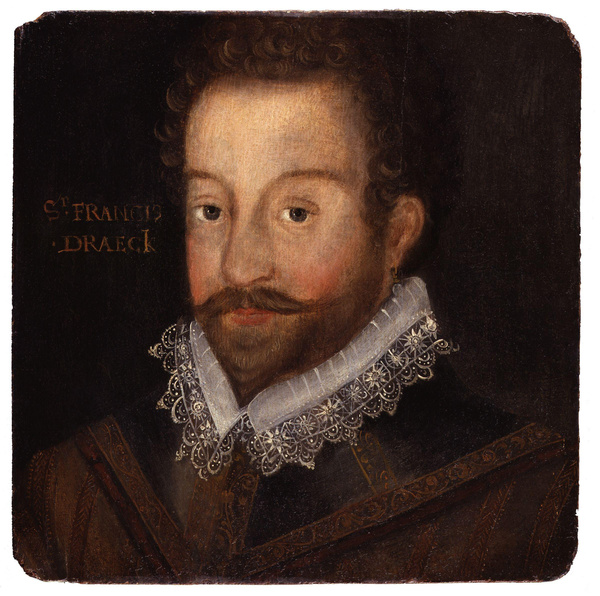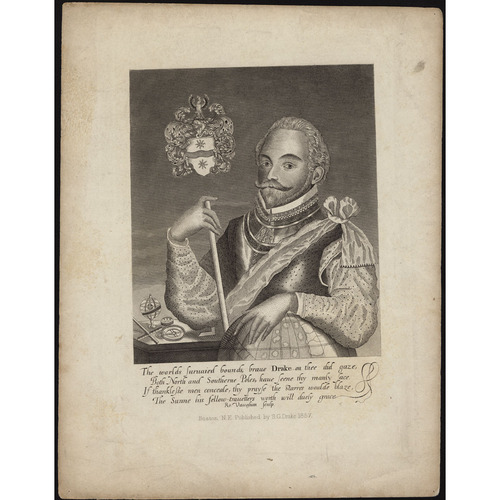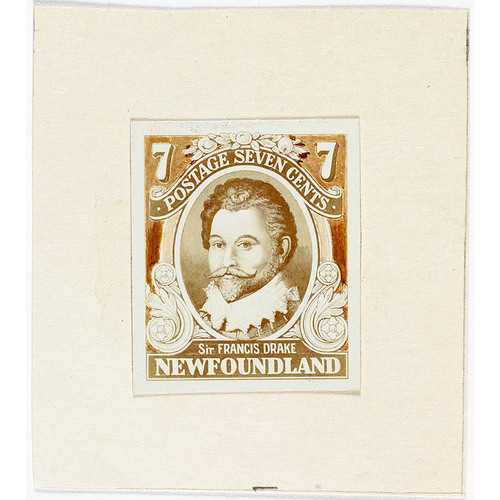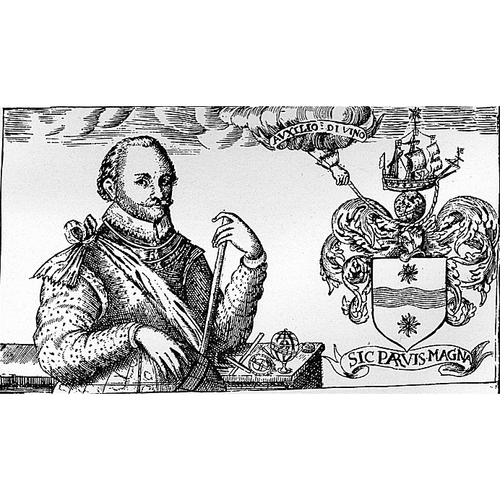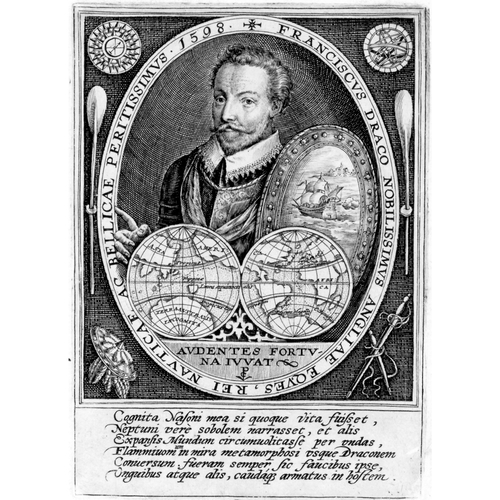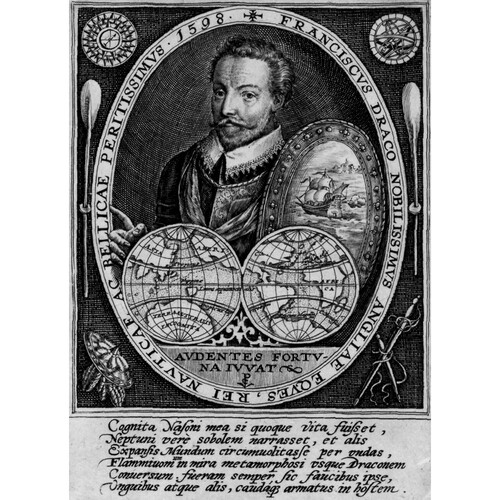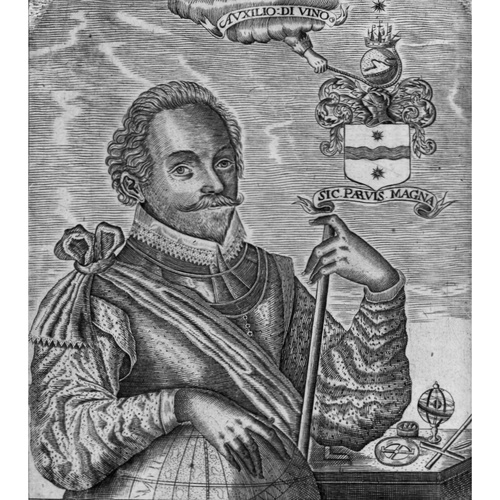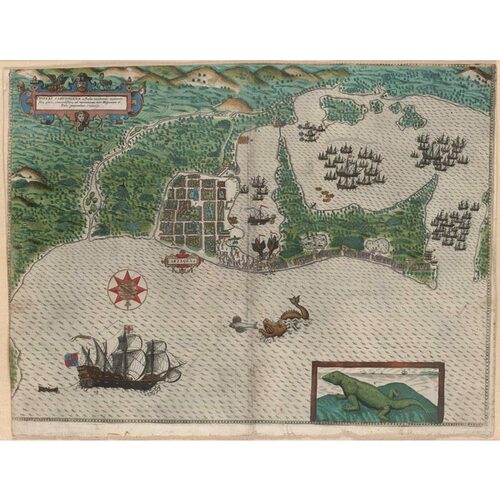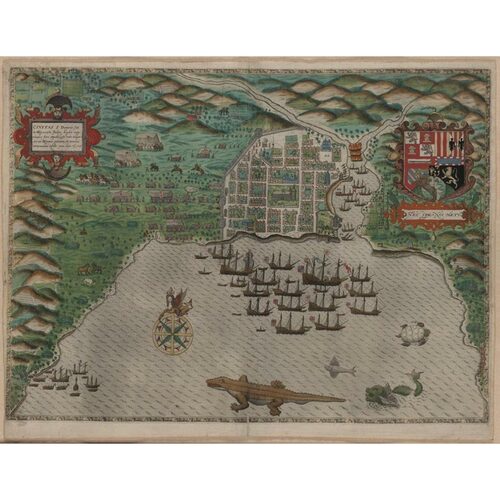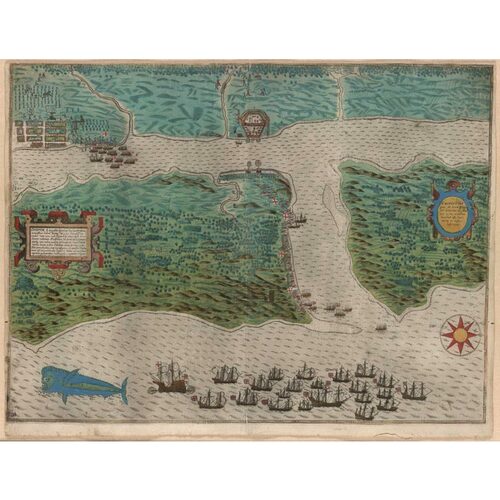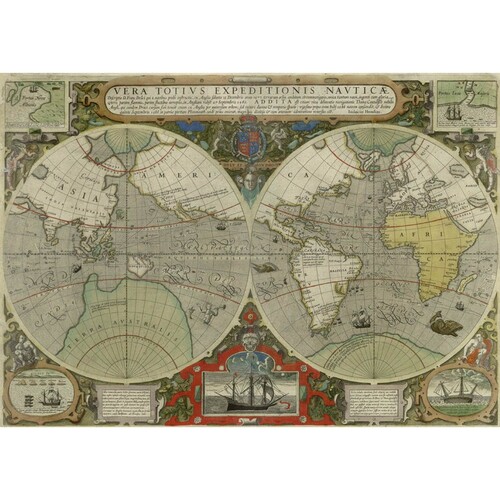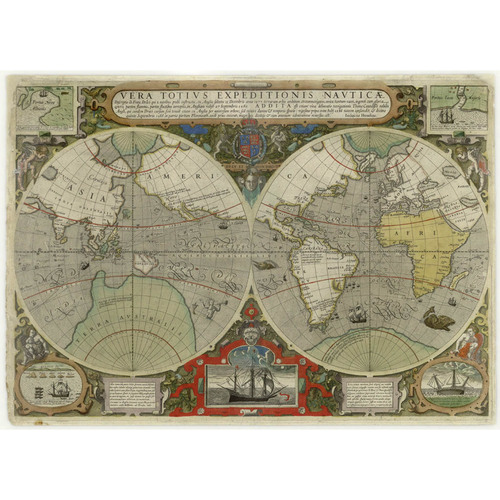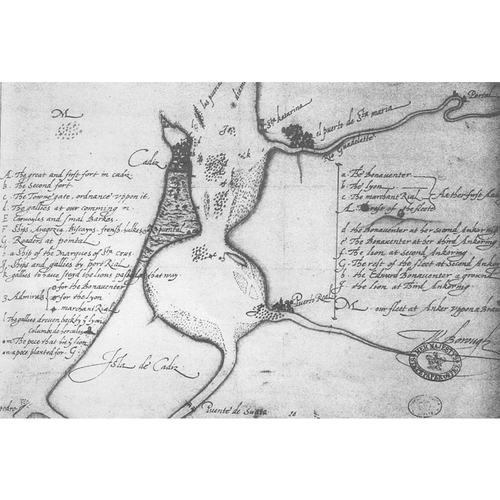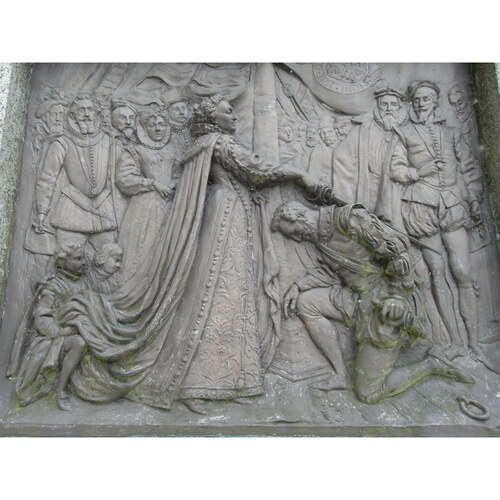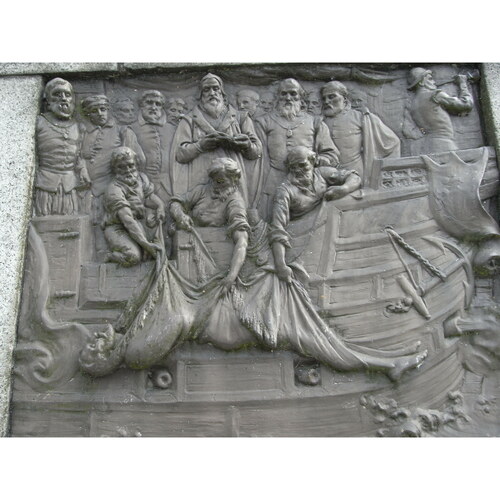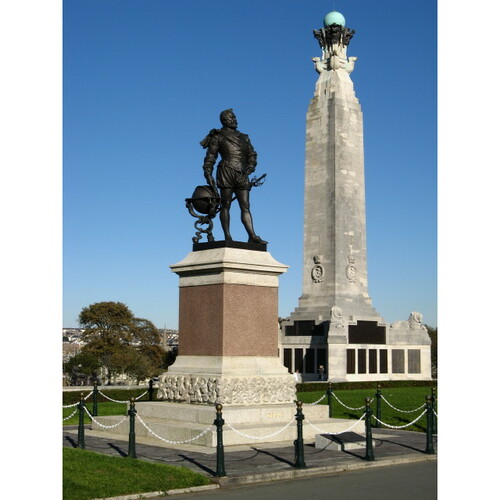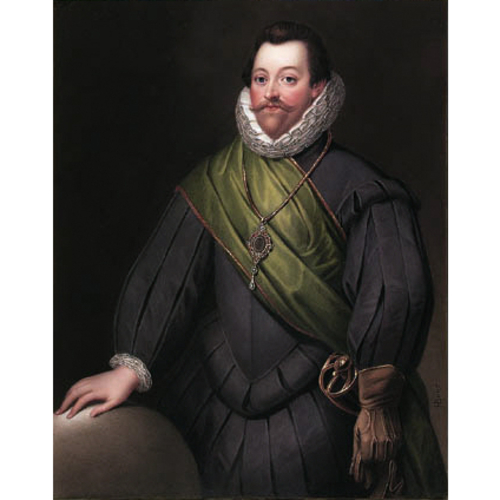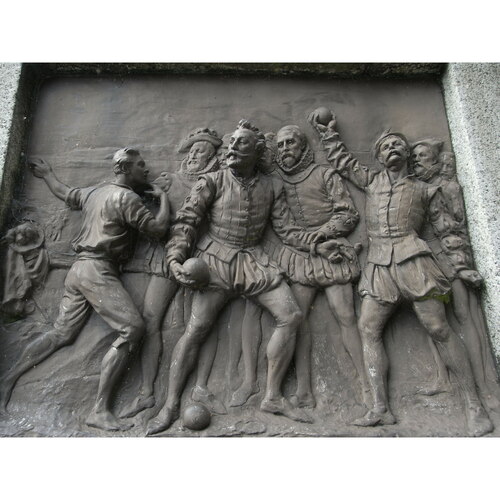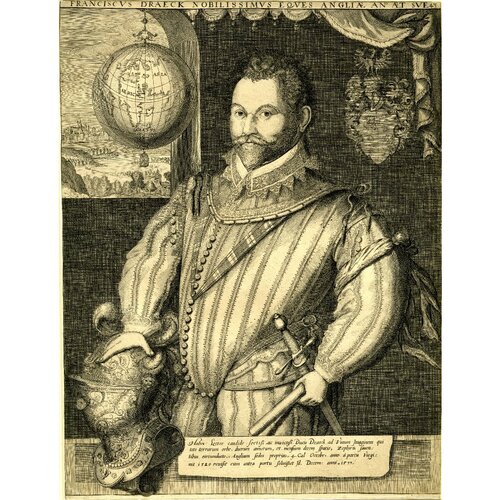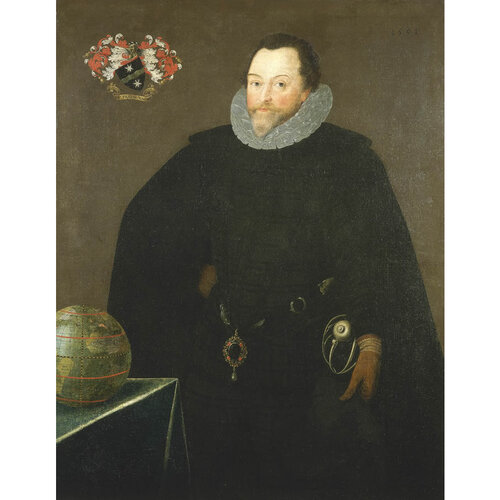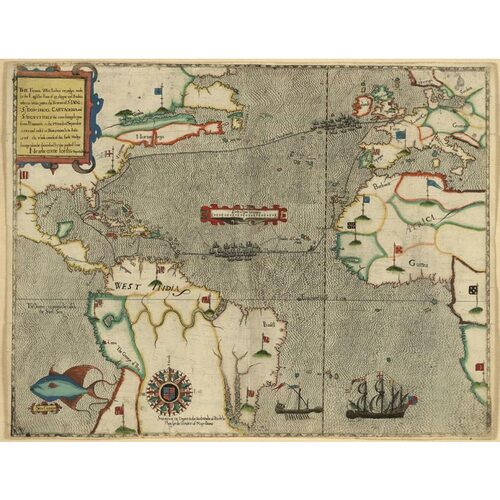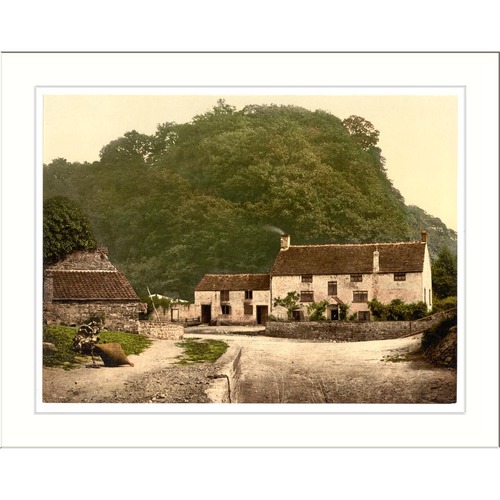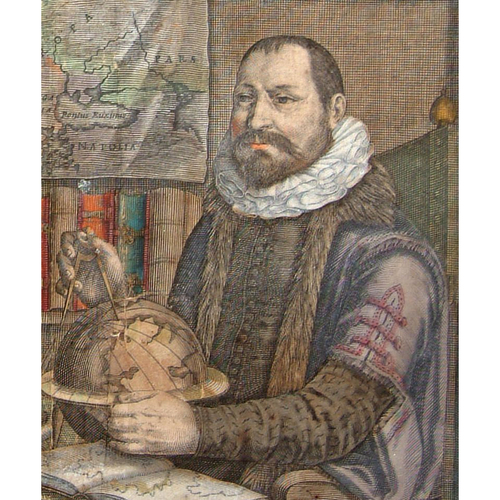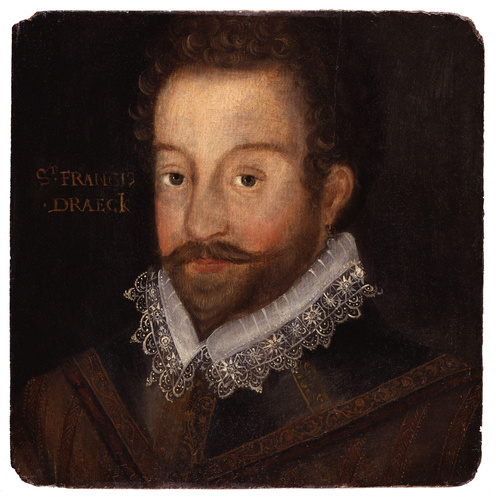DRAKE, Sir FRANCIS, English navigator, probably the first European to sight the west coast of Canada; b. near Tavistock, Devonshire c. 1540; d. 28 Jan. 1595/96 on board his ship off Portobelo, Panama.
One of the great seamen of the Elizabethan age, Drake made several voyages to the West Indies in 1565–73 and commanded a final expedition in 1595, but his fame rests chiefly upon his voyage around the world in 1577–80, for which he was knighted in 1581, and on the defeat of the Spanish Armada in 1588.
On his world voyage, Drake left Plymouth in December 1577. He spent some time in the South Atlantic; then, in September 1578, he passed through the Strait of Magellan and entered the Pacific. After harrying Spanish ships and settlements on the South and Central American coasts, he seized Huatulco in Mexico. Here, in the spring of 1579, he planned his homeward voyage. Geographical ideas at the time were much influenced by Abraham Ortelius, whose famous map of the world showed the northern coast of North America as being south of 60°, with a polar sea beyond which communicated with the Atlantic by a northwest passage and with the Pacific by the Strait of Anian. Drake decided to attempt to return to England by this polar route. He set out from Huatulco on 16 April, but some six weeks later bad weather made him change his mind, and eventually he sailed across the Pacific and Indian oceans and returned to Europe by rounding Africa.
The supposition that he sighted Canada is based upon the nature of the winds and currents that normally prevail in the North Pacific in the spring months. These revolve clockwise in a vast circle – a phenomenon noted by Claret de Fleurieu, a French naval officer, and as a consequence known as “Fleurieu’s whirlpool.” Sailing ships must take it into careful account; otherwise they may spend many days battling with head winds.
After leaving Huatulco, Drake first sailed a considerable distance to the west, and then turned north. On 5 June he was still far from the North American coast, somewhere between latitude 42º and 48º; on 17 June he dropped anchor in a bay near San Francisco. The only way in which he could possibly have travelled between these two points in only 12 days was by following the edge of the whirlpool, and being swept along by its winds and currents. These probably carried him within sight of the coast of Vancouver Island and the State of Washington, and the earliest accounts of the voyage seem to bear this out.
W. Kaye Lamb
P. R. Bishop, “Drake’s course in the north Pacific,” B.C. Hist. Q., III (1939), 151–82 (for the theory that Fleurieu’s whirlpool carried Drake within sight of the coast of Vancouver Island and the State of Washington). E. G. R. Taylor, Tudor geography, 1485–1583 (London, 1930), passim. H. R. Wagner, Sir Francis Drake’s voyage around the world (San Francisco, 1926). J. A. Williamson, The age of Drake (London, 1938), passim; Sir Francis Drake (London, 1952), passim.
Image Gallery
Crispin de Passe (Crispijn van de Passe the Elder): Portrait of Sir Francis Drake
Description: Portrait of Sir Francis Drake Artist: by Crispijn van de Passe, 1598 Source: The Kraus Collection of Sir Francis Drake Further Information: The Famous Voyage: The Circumnavigation of the World, 1577–1580, in: Sir Francis Drake: A Pictorial Biography by Hans P. Kraus
Source: Courtesy of Wikimedia Commons
Crispin de Passe (Crispijn van de Passe the Elder): Portrait of Sir Francis Drake
Description: Portrait of Sir Francis Drake Artist: by Crispijn van de Passe, 1598 Source: The Kraus Collection of Sir Francis Drake Further Information: The Famous Voyage: The Circumnavigation of the World, 1577–1580, in: Sir Francis Drake: A Pictorial Biography by Hans P. Kraus
Source: Courtesy of Wikimedia Commons
Portrait of Sir Francis Drake in The world encompassed
Description: Portrait of Sir Francis Drake; contained in: The world encompassed by Sir Francis Drake, being his next voyage to that to Nombre de Dios formerly imprinted; carefully collected out of the notes of Master Francis Fletcher, preacher in this imployment, and diuers others his followers in the same; offered now at last to publique view …, London 1628 (compiled by Francis Drake, nephew of the Admiral) Source: The Kraus Collection of Sir Francis Drake Further Information: The Famous Voyage: The Circumnavigation of the World, 1577–1580, in: Sir Francis Drake: A Pictorial Biography by Hans P. Kraus
Source: Courtesy of Wikimedia Commons
Sir Francis Drake in Cartagena 1585
Description: Sir Francis Drake in Cartagena 1585 From: Hand-colored engraving, by Baptista Boazio, 1589 Source: Library Of Congress - Jay I. Kislak Collection
Source: Courtesy of Wikimedia Commons
Sir Francis Drake in Santo Domingo 1585
Description: Sir Francis Drake in Santo Domingo 1585 From: Hand-colored engraving, by Baptista Boazio, 1589 Source: Library Of Congress - Jay I. Kislak Collection
Source: Courtesy of Wikimedia Commons
Sir Francis Drake in St. Augustine 1586
Description: Sir Francis Drake in St. Augustine 1586 From: Hand-colored engraving, by Baptista Boazio, 1589 Source: Library Of Congress - Jay I. Kislak Collection
Source: Courtesy of Wikimedia Commons
the same map, but higher resolution and black and white
Jodocus Hondius: Vera Totius Expeditionis Nauticae showing route of Francis Drakes Circumnavigation of the globe.
Description: Jodocus Hondius: Vera Totius Expeditionis Nauticae showing route of Francis Drakes and Thomas Cavendishs Circumnavigations of the globe. Amsterdam: 1595. Source: The Kraus Collection of Sir Francis Drake Further Information: The Famous Voyage: The Circumnavigation of the World, 1577–1580, in: Sir Francis Drake: A Pictorial Biography by Hans P. Kraus
Source: Courtesy of Wikimedia Commons
the same map, but higher resolution and black and white
Jodocus Hondius: Vera Totius Expeditionis Nauticae showing route of Francis Drakes Circumnavigation of the globe.
Description: Jodocus Hondius: Vera Totius Expeditionis Nauticae showing route of Francis Drakes and Thomas Cavendishs Circumnavigations of the globe. Amsterdam: 1595. Source: The Kraus Collection of Sir Francis Drake Further Information: The Famous Voyage: The Circumnavigation of the World, 1577–1580, in: Sir Francis Drake: A Pictorial Biography by Hans P. Kraus
Source: Courtesy of Wikimedia Commons
Attack on Cadiz 1587
Description: Sir Francis Drake attacks the Spanisch Armada in Cadiz 1587 From: Handmade, by William Borough, Drakes second-in-command, 1587 Source: Lopez Martin Collection
Source: Courtesy of Wikimedia Commons
Description English: Sir Francis Drake knighted by Queen Elizabeth. One of 4 bronze relief plaques on the base of the Drake statue in Tavistock, Devon. By Joseph Boehm(d.1890), donated by Hastings Russell, 9th Duke of Bedford(d.1891) Date 5 September 2011(2011-09-05) (original upload date) Source Own work Transferred from en.wikipedia Author Lobsterthermidor at en.wikipedia
Source: Courtesy of Wikimedia Commons
Description English: Sir Francis Drake buried at sea. One of 4 bronze relief plaques on the base of the Drake statue in Tavistock, Devon. By Joseph Boehm(d.1890), donated by Hastings Russell, 9th Duke of Bedford(d.1891) Date 5 September 2011(2011-09-05) (original upload date) Source Own work Transferred from en.wikipedia Author Lobsterthermidor at en.wikipedia
Source: Courtesy of Wikimedia Commons
Description English: Plymouth Hoe: Sir Francis Drake The famous Sir Fancis Drake's statue on Plymouth Hoe with the War Memorial in the background. Date 4 November 2006(2006-11-04) Source From geograph.org.uk Author Brian
Camera location 50° 21' 54.91" N, 4° 8' 31.89" W This and other images at their locations on: Google Maps - Google Earth - OpenStreetMap (Info)50.365254;-4.142191
Source: Courtesy of Wikimedia Commons
Description English: *Sir Francis Drake (c. 1540-1596), facing left in pleated grey doublet with standing lace collar and cuffs, gold-bordered green stole draped across his chest, sword at his side, holding a pair of gloves in his left hand and his right hand resting on a sphere, wearing the Drake jewel on a gold chain around his neck signed 'HBone' (lower right) and signed, inscribed and dated in full on the counter-enamel 'Sir Francis Drake. after a picture in the possession of Sir Tho:s Trayton Fuller Eliott Drake Bar:t of Nutwell Court, near Honiton Devon London, April 1829 Painted by Henry Bone R. A. Enamel painter to His Majesty & to His R. H. the late Duke of York &c &c' enamel on copper 205 x 162 mm. Date April 1829(1829-04) Source Christie's Author Henry Bone
Source: Courtesy of Wikimedia Commons
Description English: Sir Francis Drake whilst playing bowls on Plymouth Hoe is informed of the approaching Spanish Armada. One of 4 bronze relief plaques on the base of the Drake statue in Tavistock, Devon. By Joseph Boehm(d.1890), donated by Hastings Russell, 9th Duke of Bedford(d.1891) Date 5 September 2011(2011-09-05) (original upload date) Source Own work Transferred from en.wikipedia Author Lobsterthermidor at en.wikipedia
Source: Courtesy of Wikimedia Commons
Description English: "Franciscus Draeck nobilissimus Eques Angliæ ano æt sue 43," engraved portrait of Sir Francis Drake at half-length, by the Flemish cartographer and engraver Jodocus Hondius. 397 mm x 303 mm. Courtesy of the British Museum, London. Date circa 1580 Source British Museum [1] Author Jodocus Hondius
Source: Courtesy of Wikimedia Commons
Description English: Sir Francis Drake wearing the Drake Jewel or Drake Pendant at his waist, 1169 x 914 mm, National Maritime Museum, London Date 1591(1591) Source http://www.nmm.ac.uk/collections/displayRepro.cfm?reproID=BHC2662 Author Marcus Gheeraerts (II) (1561–1636) Alternative names Marcus Garrand, Marcus Garrard, Marcus Garret (II), Marcus Geeraerts the Younger, Marcus Geeraerts (II), Marcus Gerard (II) Description English painter Date of birth/death 1561(1561) or 1562(1562) (?) 19 January 1636(1636-01-19) Location of birth/death Bruges London Work location England
This is a faithful photographic reproduction of an original two-dimensional work of art. The work of art itself is in the public domain for the following reason: Public domainPublic domainfalsefalse This work is in the public domain in the United States, and those countries with a copyright term of life of th
Source: Courtesy of Wikimedia Commons
Sir Francis Drakes West Indian Voyage 1585-86
Description: Sir Francis Drakes West Indian Voyage 1585-86 From: Hand-colored engraving, by Baptista Boazio, 1589 Source: Library Of Congress - Jay I. Kislak Collection
Source: Courtesy of Wikimedia Commons
Description Sir Francis Drakes House near Severn Bridge Gatcombe England Date 8 January 2007, 23:02 Source Sir Francis Drakes House near Severn Bridge Gatcombe England Author Snapshots Of The Past
Source: Courtesy of Wikimedia Commons
Description 1577 engraving of Sir Francis Drake by Jodocus Hondius, edit by George Vertue in the 18th century and published in "Franciscus Draeck Nobilissimus Eques Angliae Ano Aet Sue 43" Date 1577(1577) Source Library of Congress Author Jodocus Hondius (1563–1612) Alternative names de Hondt, Josse. Jodocus Hondius the Elder Description Dutch cartographer Date of birth/death 14 October 1563(1563-10-14) 12 February 1612(1612-02-12) Location of birth/death Dentergem, Flanders Amsterdam Authority control VIAF: 56911926 | LCCN: n80024484 | PND: 119072149 | WorldCat | WP-Person
Source: Courtesy of Wikimedia Commons
Description English: Sir Francis Drake, by Jodocus Hondius (died 1612). See source website for additional information. This set of images was gathered by User:Dcoetzee from the National Portrait Gallery, London website using a special tool. All images in this batch have been confirmed as author died before 1939 according to the official death date listed by the NPG. Date Unknown, but author died in 1612 Source National Portrait Gallery, London: NPG 1627 While Commons policy accepts the use of this media, one or more third parties have made copyright claims against Wikimedia Commons in relation to the work from which this is sourced or a purely mechanical reproduction thereof. This may be due to recognition of the "sweat of the brow" doctrine, allowing works to be eligible for protection through skill and labour, and not purely by originality as is the case in the United States
Source: Courtesy of Wikimedia Commons
Cite This Article
W. Kaye Lamb, “DRAKE, Sir FRANCIS,” in Dictionary of Canadian Biography, vol. 1, University of Toronto/Université Laval, 2003–, accessed December 31, 2025, https://www.biographi.ca/en/bio/drake_francis_1E.html.
The citation above shows the format for footnotes and endnotes according to the Chicago manual of style (16th edition). Information to be used in other citation formats:
|
Permalink: |
https://www.biographi.ca/en/bio/drake_francis_1E.html |
|
Author of Article: |
W. Kaye Lamb |
|
Title of Article: |
DRAKE, Sir FRANCIS |
|
Publication Name: |
Dictionary of Canadian Biography, vol. 1 |
|
Publisher: |
University of Toronto/Université Laval |
|
Year of publication: |
1966 |
|
Year of revision: |
1979 |
|
Access Date: |
December 31, 2025 |
